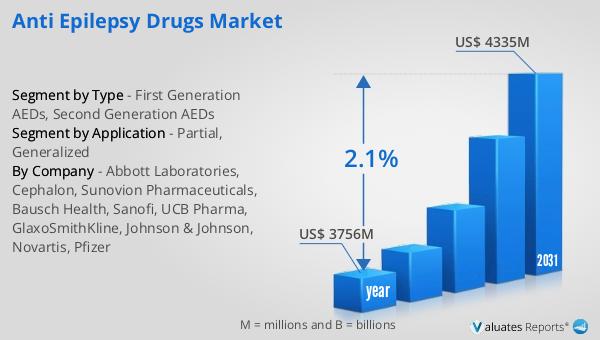What is Global Anti Epilepsy Drugs Market?
The Global Anti Epilepsy Drugs Market is a crucial segment of the pharmaceutical industry, focusing on medications designed to manage and treat epilepsy, a neurological disorder characterized by recurrent seizures. These drugs, known as antiepileptic drugs (AEDs), play a vital role in controlling seizures and improving the quality of life for individuals affected by epilepsy. The market encompasses a wide range of medications, including both first-generation and second-generation AEDs, each with unique mechanisms of action and efficacy profiles. The demand for these drugs is driven by the increasing prevalence of epilepsy worldwide, advancements in drug development, and a growing awareness of the condition. Additionally, the market is influenced by factors such as regulatory approvals, healthcare infrastructure, and the availability of generic versions of popular AEDs. As the global population continues to grow and age, the need for effective epilepsy management solutions is expected to rise, further propelling the market's expansion. The Global Anti Epilepsy Drugs Market is not only a testament to the advancements in medical science but also a beacon of hope for millions of individuals and families affected by epilepsy worldwide.

First Generation AEDs, Second Generation AEDs in the Global Anti Epilepsy Drugs Market:
First-generation antiepileptic drugs (AEDs) have been the cornerstone of epilepsy treatment for several decades. These drugs, including phenobarbital, phenytoin, carbamazepine, and valproic acid, were among the first to be developed and have been widely used due to their proven efficacy in controlling seizures. Phenobarbital, one of the oldest AEDs, works by enhancing the activity of gamma-aminobutyric acid (GABA), an inhibitory neurotransmitter in the brain, thereby reducing neuronal excitability. Phenytoin, on the other hand, stabilizes neuronal membranes by blocking sodium channels, preventing the repetitive firing of neurons that leads to seizures. Carbamazepine, similar to phenytoin, also targets sodium channels and is particularly effective in treating partial seizures and generalized tonic-clonic seizures. Valproic acid, a broad-spectrum AED, increases GABA levels and is effective against a wide range of seizure types, including absence seizures. Despite their effectiveness, first-generation AEDs are often associated with significant side effects, such as sedation, cognitive impairment, and potential teratogenic effects, which have prompted the development of newer drugs.
Partial, Generalized in the Global Anti Epilepsy Drugs Market:
Second-generation AEDs were developed to address the limitations of first-generation drugs, offering improved safety profiles and fewer side effects. These include medications like lamotrigine, levetiracetam, topiramate, and gabapentin. Lamotrigine works by inhibiting sodium channels and modulating glutamate release, making it effective for both partial and generalized seizures. It is particularly favored for its lower risk of cognitive side effects compared to older drugs. Levetiracetam, known for its unique mechanism of action, binds to synaptic vesicle protein SV2A, modulating neurotransmitter release and providing broad-spectrum seizure control. Its favorable side effect profile and minimal drug interactions make it a popular choice among clinicians. Topiramate, another second-generation AED, enhances GABA activity and blocks sodium channels, offering efficacy in treating a variety of seizure types. Gabapentin, initially developed for neuropathic pain, also exhibits antiepileptic properties by modulating calcium channels. The introduction of these second-generation AEDs has significantly expanded the therapeutic options available to patients, allowing for more personalized and effective epilepsy management. However, the choice of AEDs often depends on individual patient factors, including seizure type, age, comorbidities, and potential drug interactions.
Global Anti Epilepsy Drugs Market Outlook:
The usage of Global Anti Epilepsy Drugs Market in treating partial and generalized seizures is a critical aspect of epilepsy management. Partial seizures, also known as focal seizures, originate in a specific area of the brain and can manifest as simple partial seizures, where consciousness is preserved, or complex partial seizures, where consciousness is impaired. First-generation AEDs like carbamazepine and phenytoin have been traditionally used to manage partial seizures due to their efficacy in stabilizing neuronal membranes. However, second-generation AEDs such as lamotrigine and levetiracetam have gained popularity for their improved safety profiles and effectiveness in controlling partial seizures. These newer drugs offer the advantage of fewer side effects and better tolerability, making them suitable for long-term use.
| Report Metric | Details |
| Report Name | Anti Epilepsy Drugs Market |
| Accounted market size in year | US$ 3756 million |
| Forecasted market size in 2031 | US$ 4335 million |
| CAGR | 2.1% |
| Base Year | year |
| Forecasted years | 2025 - 2031 |
| Segment by Type |
|
| Segment by Application |
|
| Consumption by Region |
|
| By Company | Abbott Laboratories, Cephalon, Sunovion Pharmaceuticals, Bausch Health, Sanofi, UCB Pharma, GlaxoSmithKline, Johnson & Johnson, Novartis, Pfizer |
| Forecast units | USD million in value |
| Report coverage | Revenue and volume forecast, company share, competitive landscape, growth factors and trends |
